Tangerine
The tangerine (Citrus reticula L. var.,[1] sometimes referred as Citrus tangerina[2]) is a group of orange-coloured citrus fruit consisting of hybrids of mandarin orange (Citrus reticulata).
| Tangerine | |
|---|---|
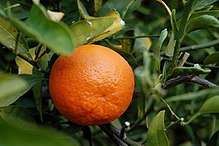 | |
| Scientific classification | |
| Kingdom: | Plantae |
| Clade: | Tracheophytes |
| Clade: | Angiosperms |
| Clade: | Eudicots |
| Clade: | Rosids |
| Order: | Sapindales |
| Family: | Rutaceae |
| Genus: | Citrus |
| Species: | C. tangerina |
| Binomial name | |
| Citrus tangerina | |
The name was first used for fruit coming from Tangier, Morocco, described as a mandarin variety.[3] Under the Tanaka classification system, Citrus tangerina is considered a separate species. Under the Swingle system, tangerines are considered a group of mandarin (C. reticulata) varieties.[4] Genetic study has shown tangerines to be mandarin orange hybrids containing some pomelo DNA.[5][6] Some differ only in disease resistance.[7] The term is currently applied to any reddish-orange mandarin (and, in some jurisdictions, mandarin-like hybrids, including some tangors).[8][9]
Tangerines are smaller and less rounded than common oranges. The taste is considered less sour, as well as sweeter and stronger, than that of an orange.[10] A ripe tangerine is firm to slightly soft, and pebbly-skinned with no deep grooves, as well as orange in color. The peel is thin, with little bitter white mesocarp.[11] All of these traits are shared by mandarins generally.
Peak tangerine season lasts from autumn to spring. Tangerines are most commonly peeled and eaten by hand. The fresh fruit is also used in salads, desserts and main dishes. The peel is used fresh or dried as a spice or zest for baking and drinks, and eaten coated in chocolate. Fresh tangerine juice and frozen juice concentrate are commonly available in the United States.
Etymology
According to the Oxford English Dictionary, the word "tangerine" was originally an adjective meaning "Of or pertaining to, or native of Tangier, a seaport in Morocco, on the Strait of Gibraltar" and "a native of Tangier." The OED cites this usage from Addison's The Tatler in 1710 with similar uses from the 1800s. The adjective was applied to the fruit, once known scientifically as "Citrus nobilis var. tangeriana" which grew in the region of Tangiers. This usage appears in the 1800s.[12] In India, it is called Narangi in Hindi (Hindi:नारंगी), Narangi means "Orange color" and hence it refers to the bright orange color of the fruit.
Nomenclature and varieties
Tangerines were first grown and cultivated as a distinct crop in the Americas by a Major Atway in Palatka, Florida.[13] Atway was said to have imported them from Morocco (more specifically its third-largest city Tangier), which was the origin of the name. Major Atway sold his groves to N. H. Moragne in 1843, giving the Moragne tangerine the other part of its name.[14]
The Moragne tangerine produced a seedling which became one of the oldest and most popular American varieties, the Dancy tangerine (zipper-skin tangerine, kid-glove orange).[14] Genetic analysis has shown the parents of the Dancy to have been two mandarin orange hybrids each with a small pomelo contribution, a Ponkan mandarin orange and a second unidentified mandarin.[5] The Dancy is no longer widely commercially grown; it is too delicate to handle and ship well, it is susceptible to Alternaria fungus, and it bears more heavily in alternate years.[15][16] Dancys are still grown for personal consumption, and many hybrids of the Dancy are grown commercially.
Until the 1970s, the Dancy was the most widely grown tangerine in the US;[17] the popularity of the fruit led to the term "tangerine" being broadly applied as a marketing name. Florida classifies tangerine-like hybrid fruits as tangerines for the purposes of sale and regulation;[8] this classification is widely used but regarded as technically inaccurate in the industry.[9] Among the most important tangerine hybrids of Florida are murcotts, a late-fruiting type of tangor marketed as "honey tangerine"[18] and Sunbursts (an early-fruiting complex tangerine-orange-grapefruit hybrid).[19] The fallglo, also a three-way hybrid (5/8 tangerine, 1/4 orange and 1/8 grapefruit), is also grown.[20]
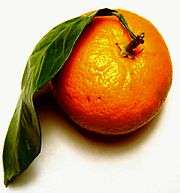 A tangerine
A tangerine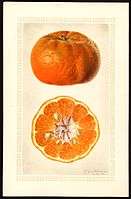 A botanical illustration of a Manurco tangerine, painted by Royal Charles Steadman in January, 1926.
A botanical illustration of a Manurco tangerine, painted by Royal Charles Steadman in January, 1926.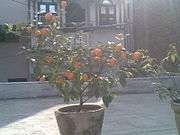 Tangerine or Narangi fruit during winters in Delhi
Tangerine or Narangi fruit during winters in Delhi Narangi tree in Mohali
Narangi tree in Mohali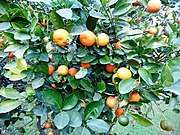 Narangi fruit
Narangi fruit
Nutrition
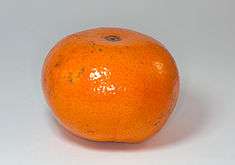 A Murcott, likely a tangerine hybrid | |
| Nutritional value per 100 g (3.5 oz) | |
|---|---|
| Energy | 223 kJ (53 kcal) |
13.34 g | |
| Sugars | 10.58 g |
| Dietary fiber | 1.8 g |
0.31 g | |
0.81 g | |
| Vitamins | Quantity %DV† |
| Vitamin A equiv. | 4% 34 μg1% 155 μg |
| Thiamine (B1) | 5% 0.058 mg |
| Riboflavin (B2) | 3% 0.036 mg |
| Niacin (B3) | 3% 0.376 mg |
| Pantothenic acid (B5) | 4% 0.216 mg |
| Vitamin B6 | 6% 0.078 mg |
| Folate (B9) | 4% 16 μg |
| Choline | 2% 10.2 mg |
| Vitamin C | 32% 26.7 mg |
| Vitamin E | 1% 0.2 mg |
| Minerals | Quantity %DV† |
| Calcium | 4% 37 mg |
| Iron | 1% 0.15 mg |
| Magnesium | 3% 12 mg |
| Manganese | 2% 0.039 mg |
| Phosphorus | 3% 20 mg |
| Potassium | 4% 166 mg |
| Sodium | 0% 2 mg |
| Zinc | 1% 0.07 mg |
| Other constituents | Quantity |
| Water | 85.2 g |
| |
| †Percentages are roughly approximated using US recommendations for adults. Source: USDA Nutrient Database | |
Tangerines contain 85% water, 13% carbohydrates, and negligible amounts of fat and protein (table). Among micronutrients, only vitamin C is in significant content (32% of the Daily Value) in a 100 gram reference serving, with all other nutrients in low amounts.
References
- Mandal, Shyamapada; Mandal, Manisha (2016). "Tangerine (Citrus reticulata L. Var.) Oils". Essential Oils in Food Preservation, Flavor and Safety. pp. 803–811. doi:10.1016/B978-0-12-416641-7.00091-2. ISBN 978-0-12-416641-7.
- "Citrus tangerina Yu.Tanaka — The Plant List". theplantlist.org.
- "Home : Oxford English Dictionary". oed.com.
- Froelicher, Yann; Mouhaya, Wafa; Bassene, Jean-Baptiste; Costantino, Gilles; Kamiri, Mourad; Luro, Francois; Morillon, Raphael; Ollitrault, Patrick (2011). "New universal mitochondrial PCR markers reveal new information on maternal citrus phylogeny". Tree Genetics. 7: 49–61. doi:10.1007/s11295-010-0314-x.
- Wu, Guohong Albert; Terol, Javier; Ibanez, Victoria; López-García, Antonio; Pérez-Román, Estela; Borredá, Carles; Domingo, Concha; Tadeo, Francisco R; Carbonell-Caballero, Jose; Alonso, Roberto; Curk, Franck; Du, Dongliang; Ollitrault, Patrick; Roose, Mikeal L. Roose; Dopazo, Joaquin; Gmitter Jr, Frederick G.; Rokhsar, Daniel; Talon, Manuel (2018). "Genomics of the origin and evolution of Citrus" (PDF). Nature. 554 (7692): 311–316. Bibcode:2018Natur.554..311W. doi:10.1038/nature25447. PMID 29414943. and Supplement
- G Albert Wu; et al. (2014). "Sequencing of diverse mandarin, pomelo and orange genomes reveals complex history of admixture during citrus domestication". Nature Biotechnology. 32 (7): 656–662. doi:10.1038/nbt.2906. PMC 4113729. PMID 24908277.
- Li, Xiaomeng; Xie, Rangjin; Lu, Zhenhua; Zhou, Zhiqin (2010). "The Origin of Cultivated Citrus as Inferred from Internal Transcribed Spacer and Chloroplast DNA Sequence and Amplified Fragment Length Polymorphism Fingerprints". Journal of the American Society for Horticultural Science. 135 (4): 341–350. doi:10.21273/JASHS.135.4.341.
- Commernet, 2011. "20-13.0061. Sunburst Tangerines; Classification and Standards, 20-13. Market Classification, Maturity Standards And Processing Or Packing Restrictions For Hybrids, D20. Departmental, 20. Department of Citrus, Florida Administrative Code". State of Florida. Retrieved 14 May 2015.
- Larry K. Jackson & Stephen H. Futch. "HS178/CH073: Robinson Tangerine". Retrieved 14 May 2015.
- Pittman & Davis (22 February 1999). "Pittman & Davis – Premium Citrus Fruit Gifts – Why Are Tangerines So Tangy?". Pittmandavis.com. Retrieved 17 November 2012.
- David Karp (28 January 2011). "Market Watch: The wild and elusive Dancy". LA Times. Retrieved 19 July 2015.
- See the Oxford English Dictionary, 2nd edition, 1989.
- H. Harold Hume (1913). Citrus Fruits and Their Culture. O. Judd Company. p. 101.
- "dancy". www.citrusvariety.ucr.edu. Retrieved 2 May 2018.
- Larry K. Jackson & Stephen H. Futch (6 June 2018). "HS169/CH074: Dancy Tangerine". ufl.edu.
- "Satsuma cultivars: The best and the worst". AL.com. 30 October 2009. Retrieved 14 May 2015.
- USA, Slow Food. "Dancy Tangerine". Slowfood USA. Retrieved 2 May 2018.
- "HS174/CH078: Murcott (Honey Tangerine)". Edis.ifas.ufl.edu. Retrieved 17 November 2012.
- "HS168/CH079: Sunburst Tangerine". Edis.ifas.ufl.edu. Retrieved 17 November 2012.
- Larry K. Jackson & Stephen H. Futch. "HS173/CH075: Fallglo Tangerine". Retrieved 14 May 2015.
External links


